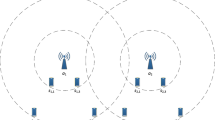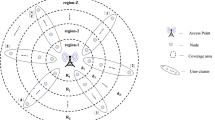Abstract
In recent years, with the ever-increase connectivity, high-density deployment scenarios have become important scenarios for future wireless networks. Achieving extreme high throughput (EHT) in high-density deployment scenarios is the technical goal of IEEE 802.11be, the next generation wireless local area network (WLAN) standard. However, the severe interference and suppression relationship between basic service set (BSS) in the high-density deployment scenario causes the throughput of the WLAN to be very severely affected. Therefore, this paper proposes an access point (AP) coordination-based non-orthogonal multiple access (NOMA) protocol named Co-NOMA for the next generation WLANs standard. Its core idea is to transform the relationship between interference and suppression between neighboring BSS into a relationship of mutual coordination and assistance through AP coordination and NOMA methods. Specifically, this article first designed the media access control (MAC) protocol based on AP coordination technique and NOMA method. Moreover, the protocol and its frame structure have good backward compatibility. According to the theoretical analysis, the proposed AP coordination based NOMA scheme has significant performance gains which is proved in the simulation.

















Similar content being viewed by others
References
Ericsson Mobility Report (2019) Experiences from Smart Fixed Wireless Access Deployment Technical report
Cisco Visual Networking Index (2019) Global Mobile Data Traffic Forecast Update, 2017–2022 Technical report
IEEE 802.11ax (D3.0) Draft Standard for Information technology Telecommunications and information exchange between systems Local and metropolitan area networks Specific requirements-Part 11: Wireless LAN medium access control (MAC) and physical layer (PHY) specifications (2018)
IEEE 802.11ax proposed draft specification. http://www.tp-ontrol.hu/index.php/TP Toolbox (2016)
Liu Y, Qin Z, Elkashlan M et al (2017) Non-orthogonal Multiple Access for 5G and Beyond. Proc IEEE 105(12)
Ding Z, Peng M, Vincent H (2015) Cooperative Non-Orthogonal Multiple Access in 5G Systems. IEEE Commun Lett 19(8)
Li X, Ma W, Luo L et al (2018) Power allocation for NOMA system in downlink, Xi Tong Gong Cheng Yu Dian Zi Ji Shu. Syst Eng Electron 40(7):1595–1599
Cao Y, Yang Z, Feng Y (2017) New NOMA power allocation strategy, Tongxin Xuebao. Journal on. Communications 38(10):157–165
Islam S, Avazov N, Dober O (2016) Power-domain non-orthogonal multiple access (NOMA) in 5G systems: potentials and challenges. IEEE Communications Surveys and Tutorials
WangL C, Chen J, Chen Y (2016) Power Allocation for a Downlink Non-Orthogonal Multiple Access System. IEEE Wireless Communications Letters
Alabbsai Z, Daniel K (2015) Power allocation for sum rate maximization in non-orthogonal multiple access system. 2015 IEEE 26th International Symposium on Personal Indoor and Mobile Radio Communications-(PIMRC): Mobile and Wireless Networks
Oviedo J, Sadjadpour H (2016) A new NOMA approach for fair power allocation. 2016 IEEE Conference on Computer Communications Workshops (INFOCOM WKSHPS)
Datta S, Kalyanasundaram S (2016) Optimal power allocation and user selection in non-orthogonal multiple access systems. IEEE Wireless Communications and Networking Conference (WCNC 2016)-Track 2-MAC and Cross Layer Design
Evangelista J, Sattar Z, Kaddoum G et al (2018) Fairness and Sum-Rate Maximization via Joint Channel and Power Allocation in Uplink SCMA Networks
Han S, Huang Y, Meng W et al (2019) Optimal Power Allocation for SCMA Downlink Systems Based on Maximum Capacity. IEEE Trans Commun 67(2):1480–1489
Chen J, Wang Z, Xiang W et al (2018) Outage Probability Region and Optimal Power Allocation for Uplink SCMA Systems. IEEE Trans Commun 66(10):4965–4980
Bo Y, Shotaro K, Koji Y et al (2017) Starvation Mitigation for Dense WLANs through Distributed Channel Selection: Potential Game Approach. 2017 14th IEEE Annual Consumer Communications and Networking Conference (CCNC), 548–553
Qu Q, Li B, Yang M et al (2019) Survey and Performance Evaluation of the Upcoming Next Generation WLANs Standard - IEEE 802.11ax. Mobile Networks and Applications 24(5):1461–1474
Yang M, Li B, Yan Z (2020) MAC Technology of IEEE 802.11ax: Progress and Tutorial. Mobile Networks and Applications
Bellalta B, Kosekszott K (2018) AP-initiated Multi-User Transmissions in IEEE 802.11ax WLANs. Ad Hoc Netw
Kyuhaeng L (2019) Performance Analysis of the IEEE 802.11ax MAC Protocol for Heterogeneous Wi-Fi Networks in Non-Saturated Conditions. Journal of Sensors 19(7)
Kiryanov A, Krotov A, Lyakhov A et al (2019) Algorithm for Dynamic Power Control and Scheduling in IEEE 802.11ax Infrastructure NetworksSpringer. J Commun Technol Electron 64(8):900–909
Ericsson: The power of 5g is here and will continue to spread across the globe in the coming years. Ericsson Mobility Report
Qiao J, He Y, Shen X (2018) Improving video streaming quality in 5g enabled vehicular networks. IEEE Wirel Commun 25(2):133–139
Fan Q, Yin H, Min G et al (2018) Video delivery networks: Challenges, solutions and future directions. Comput Electr Eng 66:332–341
Zhao G, Imran M, Pang Z et al (2019) Toward real-time control in future wireless networks: Communication-control co-design. IEEE Commun Mag 57(2):138–144
Cariou L, Stacey R, Cordeiro C et al (2019) 802.11be timeline proposal. doc.: Ieee 802.11-19/0787r2. IEEE TGbe Proposal, 1–16
Yang M, Li B, Yan Z et al (2019) AP coordination and full-duplex enabled multi-band operation for the next generation wlan: Ieee 802.11be (eht). In The 11th International Conference on Wireless Communications and Signal Processing, 1–7
Guo Y, Huang G, Yu J et al (2019) AP coordination in eht.doc.:Ieee 802.11-19/0801r0. IEEE TGbe Proposal, 1–12
Nan L, Bo S, Chen J et al (2019) Consideration on multi-ap coordination. doc.: Ieee 802.11-19/1219r0. IEEE TGbe Proposal, 1–8
Guo Y, Huang G, Yang B (2019) A unified transmission procedure for multi-AP coordination, doc.: Ieee 802.11-19/1102r0. IEEE TGbe Proposal, 1–8
Doostnejad R, Cariou L, Chen X et al (2019) Multi-ap collaborative bf in ieee 802.11, doc.: Ieee 802.11-19/0772r0. IEEE TGbe Proposal, 1–18
Yang B, Lv Y, Chen P (2019) Consideration on joint transmission, doc.: Ieee 802.11-19/1595r0. IEEE TGbe Proposal, 1–12
Verma L, Cherian G, Wentink M (2019) Coordinated ap time/frequency sharing in a transmit opportunity in 11be, doc.: Ieee 802.11-19/1582r0. IEEE TGbe Proposal, 1–12
Li B, Qu Q, Yan Z et al (2015) Survey on ofdma based mac protocols for the next generation wlan. In 2015 IEEE Wireless Communications and Networking Conference Workshops (WC-NCW), 131–135
Su S, Chih T, Wang Y (2019) Application of Power Control to Improve System Throughput in IEEE 802.11 WLAN. 2019 11th International Conference on Computational Intelligence and Communication Networks, 46–52
Ghazi H, Wesolowski K (2019) Improved Detection in Successive Interference Cancellation NOMA OFDM Receiver. IEEE Access 7:103325–103335
Kyungseop S, Ohyun J (2017) Joint Scheduling and Power Allocation Using Non-Orthogonal Multiple Access in Directional Beam-Based WLAN Systems. IEEE Wireless Communications Letters 6(4):482–485
Uddin M (2019) Throughput performance of NOMA in WLANs with a CSMA MAC protocol. Wirel Netw 25(6):3365–3384
Kheirkhah S, Pedram P, Hossein Y et al (2020) A Practical Downlink NOMA Scheme for Wireless LANs. IEEE transactions on communications 68(4):2236–2250
Tian Z, Wang J, Wang J (2017) More clients connected by NOMA in the downlink transmission of WLANs. 2017 13th International Wireless Communications and Mobile Computing Conference, 1968–1973
Evgeny K, Aleksey K, Ilya L (2020) Prototyping and Experimental Study of Non-Orthogonal Multiple Access in Wi-Fi Networks. IEEE Netw 34(4):210–217
Liu Y, Chen X, Niu Y et al (2018) Mobility-aware transmission scheduling scheme for millimeter-wave cells. IEEE Trans Wirel Commun 17(9):5991–6004
Niu Y, Ding W, Wu H, et al (2019) Relay-assisted and QoS aware scheduling to overcome blockage in mmWave backhaul networks. IEEE Trans Veh Technol 68(2):1733–1744
Chen X, Zhao Y, Li Y et al (2018) Social trust aided D2D communications: Performance bound and implementation mechanism. IEEE Journal on Selected Areas in Communications 36(7):1593–1608
Ahmed M, Shi H, Chen X0, et al (2018) Socially aware secrecy-ensured resource allocation in D2D underlay communication: An overlapping coalitional game scheme. IEEE Trans Wirel Commun 17(6):4118–4133
Acknowledgements
This work was supported in part by the National Natural Science Foundations of CHINA (Grant No. 61871322, No. 61771392, and No. 61771390), and Science and Technology on Avionics Integration Laboratory and the Aeronautical Science Foundation of China (Grant No. 20185553035, and No. 201955053002).
Author information
Authors and Affiliations
Corresponding author
Additional information
Publisher's Note
Springer Nature remains neutral with regard to jurisdictional claims in published maps and institutional affiliations.
Rights and permissions
Springer Nature or its licensor (e.g. a society or other partner) holds exclusive rights to this article under a publishing agreement with the author(s) or other rightsholder(s); author self-archiving of the accepted manuscript version of this article is solely governed by the terms of such publishing agreement and applicable law.
About this article
Cite this article
Yan, Z., Yang, M. & Zhang, X. Co-NOMA: AP Coordination Based NOMA Protocol for the Next-Generation WLANs. Mobile Netw Appl 28, 1059–1075 (2023). https://doi.org/10.1007/s11036-023-02144-4
Accepted:
Published:
Issue Date:
DOI: https://doi.org/10.1007/s11036-023-02144-4




